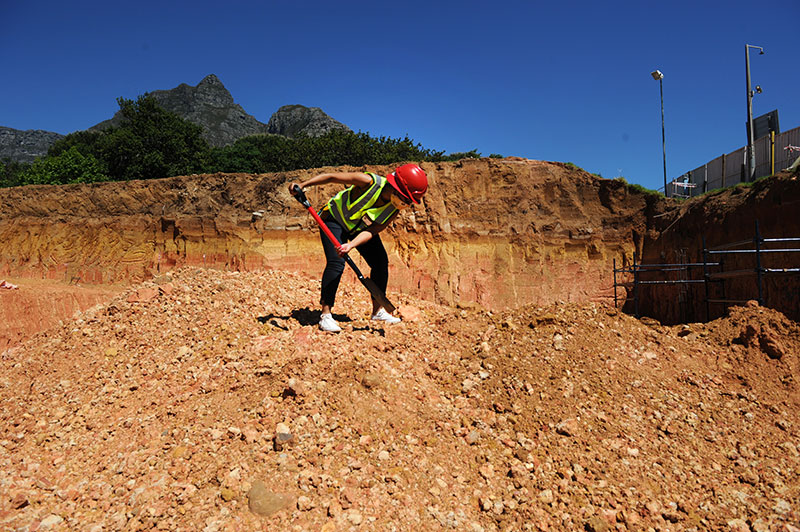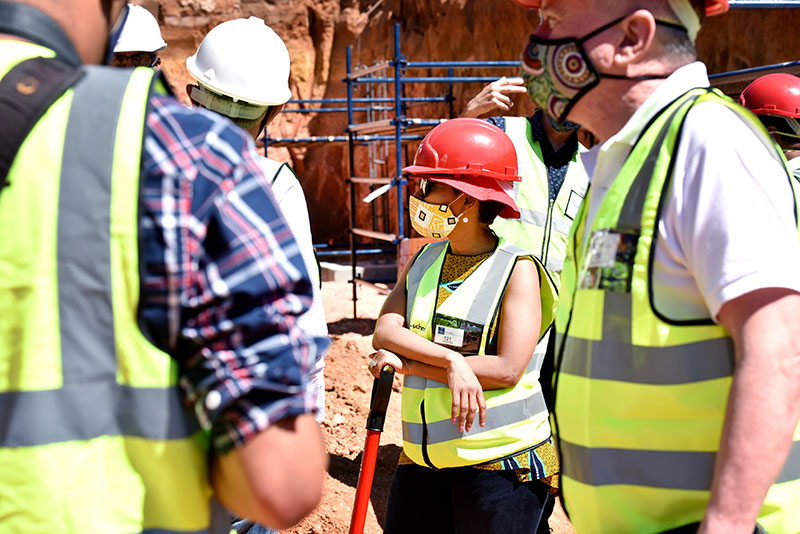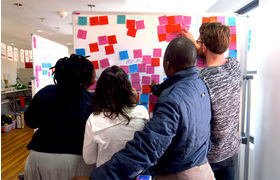d-school solar energy system first of a proposed campus roll-out
27 November 2020 | Story Helen Swingler. Photos Lerato Maduna. Voice Lerato Molale. Read time 6 min.
Right now, it’s a deep hole on a site at the corner of Woolsack Drive and Cross Campus Road on the University of Cape Town’s (UCT) middle campus. But soon the four-storey Hasso Plattner School of Design Thinking (d-school) will rise, and with it a new era of solar energy on campus.
Through the Office of the Vice Chancellor’s Environmental Sustainability Directorate, UCT has led a detailed technical and financial feasibility study for the potential of rooftop solar photovoltaic (PV) installations across all campuses, said Manfred Braune, the director of environmental sustainability.
He was speaking soon after Vice-Chancellor Professor Mamokgethi Phakeng’s 20 November site visit at which a model of the building was unveiled. Chief among the building’s sustainable features is an energy-saving 63.5 kWpeak (or kWp) grid-tied PV system (solar energy). This will be installed on the roof by Solareff, who was awarded the tender for the contract.
As the d-school’s roof will feature a large section of fritted low-emissivity (low-e) glass for the atrium, reducing the available roof surface area, a high-power-class monocrystalline module is being proposed to achieve maximum energy yields, said Solareff project manager, Leigh-An Becker.
The energy fed into the building’s grid will be used to supplement the electricity from the municipality, and although the building won’t be self-sufficient, its reliance on the municipal grid will be reduced significantly, she added.
The PV’s monitoring system will be cloud-based, allowing monitoring to be done online from anywhere. The data can be accessed via the internet and smartphone applications or set up on a smart TV in the d-school, which is part of the proposal to create awareness among students, staff and visitors about the free energy generated by the sun.
Feasibility study
Braune said that the broader feasibility study for further solar PV systems across all campuses has identified at least another 30 sites or buildings considered to be technically and financially viable.
“The preference is for these sites and buildings to be spread across all UCT’s campuses to give each campus a share of the benefit and exposure,” he added. “The intent of the project scope was also to incorporate ongoing research opportunities linked to these PV systems.”
In this regard, Braune has been consulting with Professor Edward Boje of the Department of Electrical Engineering for input and direction, to allow this project to become part of UCT’s living lab for sustainability.

Technical expertise was secured through a tender process, and Braune worked closely with tender winners Arup to produce the study over the past year.
“UCT is now able to understand the implication of a proposed solar PV roll-out from a technical, financial, heritage and implementation perspective,” he said.
The university is drawing up a funding application to the Department of Higher Education and Training for the solar PV roll-out and, as a back-up plan, is also exploring other funding opportunities with least risk and maximum return for the institution.
Green-star rating
Other sustainable features include rainwater harvesting, a design that accentuates low-energy, natural air and light and a flexible design for different spatial configurations. The underground parking area also has bays for electric cars.
The d-school is aiming at a six-star Green Star rating from the Green Building Council South Africa, a status conferred on world leaders in environmental sustainability. If successful, it will be the first six-star Green Star-rated academic building in Africa.
Speaking after her visit to the huge hole in the ground in preparation for the foundations – and shovelling piles of rubble for the cameras in the hot November sun – guest of honour, Professor Phakeng, said that she was delighted by the solar energy and other environmental features.
“This is in line with UCT’s Vision 2030, built on three pillars, the third of which is sustainability,” she said.

It also reflects Hasso Plattner’s personal commitment to sustainable development, one of the d-school’s four core values.
Phakeng said that the space, location and the design represented the future: “It brings different disciplines together from different parts of the university to create the 2030 future that we want.”
“It’s great that the students were part of the design and that their voices are in the building [design].”
She said that she was thrilled by the collaborative aspect underpinning the d-school’s design, where alumni and students joined the design-thinking process.
“It’s great that the students were part of the design and that their voices are in the building [design] and it wasn’t imposed on them. It came through a participative process. This is exciting ... sustainability [must be] in everything that we do; it’s going to take us into the future. So, the buildings, our transformation process, our excellence must be sustainable.
“With this building we’ve seen that you can create excellence in a transformative manner to ensure that we are sustainable – not only financially but environmentally too. There is also a social aspect, as the ideal is to bring people from different disciplines to work together on solving the problems of our continent and the world.”
Phakeng added: “It’s great: the energy, the solar panels, the parking compatible for electric cars – that’s future thinking.”
 This work is licensed under a Creative Commons Attribution-NoDerivatives 4.0 International License.
This work is licensed under a Creative Commons Attribution-NoDerivatives 4.0 International License.
Please view the republishing articles page for more information.










